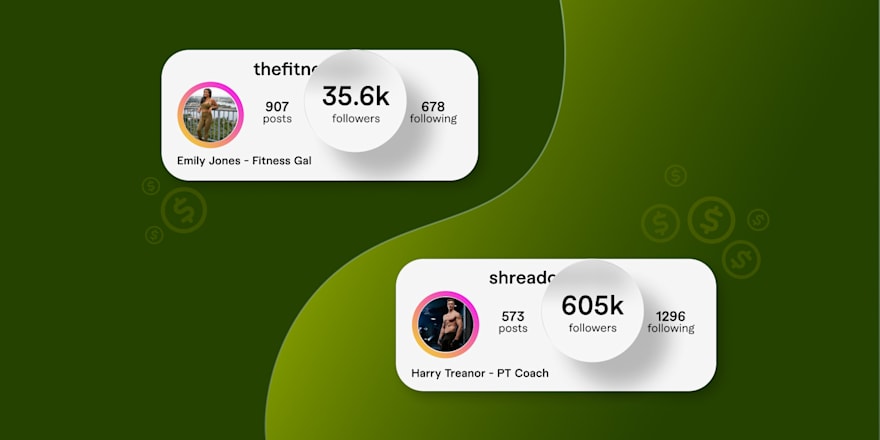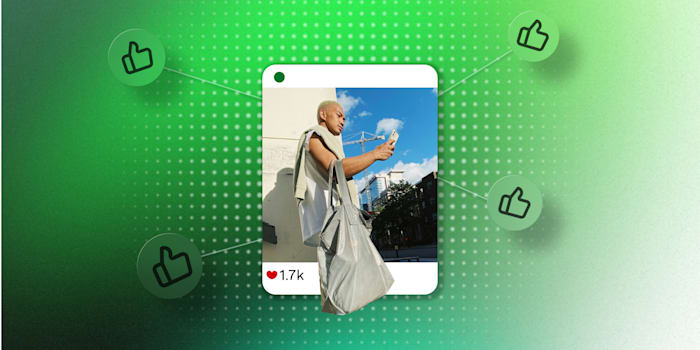Micro vs Macro-Influencers: What’s The Difference? (2025)
Discover how to leverage micro and macro-influencers for maximum impact.
 January 24, 2025
January 24, 2025 9 minute reading
9 minute reading
The influencer marketing world is split between two powerful forces: intimate micro-influencers who command devoted niche audiences and macro-influencers who reach millions—but cost more.
As social media and influencer marketing evolves, brands are learning how to use both for maximum impact. A Linqia study found that 81% of brands worked with macro-influencers, while 74% worked with micro-influencers.
This guide will break down both groups' strengths, how much it costs to work with each, and how to pick the right influencer partnership for your brand.
What is a micro-influencer?
A micro-influencer has between 10,000 and 100,000 followers on social media. Think of them as trusted friends who give recommendations to a tight-knit community—rather than well-known influencers or celebrities speaking to millions.
Micro-influencers are most commonly found on:
Instagram: Sharing lifestyle content, products, and daily life.
TikTok: Creating short videos about specific topics or niches.
YouTube: Making detailed content about their expertise.
Brands love collaborations with micro-influencers because:
They tend to have closer relationships with their audience and higher engagement rates than mega-influencers
They're more affordable than macro-influencers
They often focus on specific niches so brands can reach precisely the right audience
For example, a small organic skincare brand might prefer working with a UGC creator with 50,000 followers who focuses on clean beauty rather than a celebrity with millions of followers since they'll reach people already interested in natural products.
If you want to learn more about micro-influencer marketing, read our full guide dedicated to this topic.
What is a macro-influencer?
A macro-influencer has a larger social media following, typically between 100,000 to 1 million followers. They are like digital celebrities and come with a higher influencer marketing cost.
Brands often work with macro-influencers because they can reach many people at once. The bigger account sizes often generate widespread and quick buzz around products.
A typical example would be a fitness trainer with 500,000 Instagram followers who partners with workout gear brands or a beauty guru on YouTube who promotes skincare products to 750,000 subscribers.
Micro vs. macro-influencers: What’s the difference?
The primary difference between micro- and macro-influencers lies in their follower count and the type of impact they offer.
Micro-influencers typically have 10,000 to 100,000 followers and focus on niche audiences with highly engaged communities. Their content feels personal and relatable, which builds trust and encourages authentic interactions.
Macro-influencers, on the other hand, have larger followings ranging from 100,000 to 1 million. They deliver broader reach and are ideal for campaigns aiming to maximize visibility, though their engagement rates are generally lower due to their diverse and expansive audience.
In essence, micro-influencers excel at creating authentic, community-driven content, while macro-influencers are better suited for large-scale campaigns that prioritize visibility and brand awareness.
Both can play critical roles in achieving specific marketing goals, depending on the campaign’s focus.
Let’s now look at some of the most important distinctions between these two particular groups.
Follower count
The exact follower thresholds can vary depending on the platform and industry, but these are the commonly accepted ranges.
Micro-influencers have between 10,000 and 100,000 followers
Macro-influencers have between 100,000 and 1 million followers
Reach
Micro-influencers Reach
Average impressions per post: 5,000-30,000
Strongest performance on vertical video content
A higher percentage of followers see their content
More concentrated engagement within their immediate community
Macro-influencers Reach
Average impressions per post: 100,000-500,000+
Content frequently amplified by platform algorithms
Viral potential reaches beyond their direct follower base
Highest reach achieved through TikTok and Instagram Reels
Hire UGC video creators
Engagement rate
Micro-influencers engagement
Higher overall engagement rates, typically 3-8% on Instagram
Stronger personal connections with their audience lead to more meaningful interactions
Comments tend to be more detailed and conversational
Followers often feel more connected and invested in the content
Macro-influencers engagement
Lower engagement rates, typically 1-3% on Instagram
Higher total number of engagements despite a lower percentage
Comments tend to be more superficial due to a larger audience
Trade broader reach for decreased engagement intensity
Cost per engagement (CPE)
CPE stands for Cost Per Engagement, which refers to the amount a brand pays for each engagement (like a like, comment, share, or click) an influencer generates with their content. It helps brands assess the cost-effectiveness of their campaigns based on the interactions they receive from the influencer's audience.
Based on data from the same Later report referenced above, here is the average cost per engagement rate for each type of influencer:
Micro-influencers CPE
Instagram Posts: $0.74 CPE
Instagram Reels: $1.15 CPE
TikTok: $2.01 CPE
Macro-influencers CPE
Instagram Posts: $0.99 CPE
Instagram Reels: $2.19 CPE
TikTok: Data not available
Content production value
Micro-influencers content production value
Micro-influencers usually produce content with basic equipment. For example, a local fitness influencer films workout routines in their home gym using a smartphone. They offer pure, organic UGC for brands of all sizes.
Sometimes, these accounts are still looking to become influencers and would be happy to shout out and promote your brand for an affordable price.
Macro-influencers content production value
Macro-influencers typically create highly polished content using professional equipment and teams. For example, a fashion influencer posts professionally lit photoshoots with multiple outfit changes in exotic locations.
Authenticity
Micro-influencers authenticity
Micro-influencers are often viewed as more trustworthy because they feel like recommendations from a friend. Think of someone genuinely using and reviewing a skincare product in their bathroom mirror during their nightly routine and then posting it with a caption online. Check our here some expert tips on influencer marketing authencity.
Macro-influencers authenticity
Macro-influencers can seem more commercial due to celebrity status and professional distance from their audience. Think of a popular account promoting a product with a staged unboxing video in a perfectly styled studio setting.
How to choose between a micro-influencer and a macro-influencer
Given the differences between micro-influencers and macro-influencers, how do you choose the right influencer type for your social marketing campaign? There are four criteria.
Budget
Campaign objectives
Target audience
ROI expectations
Budget
Your marketing budget is the first factor that will narrow down your choices. Micro-influencers are significantly more affordable, making them ideal for campaigns under $10,000.
They deliver better engagement per dollar spent, though you'll likely need to work with several to reach your goals. If your budget exceeds $50,000, you have the flexibility to work with macro-influencers or create a mix of both types.
While social media influencers with larger followings may seem appealing, those with smaller followings often provide more budget-friendly options for your influencer marketing strategy, allowing you to achieve broad reach through multiple targeted content creation efforts.
Campaign objectives
Campaign goals shape your strategy. Influencers with fewer followers tend to maintain higher content quality. They can more effectively communicate your brand message, while larger influencers help establish broader audience reach and improve overall brand perception through their influencer marketing campaigns. Micro-influencers excel at driving engagement and creating authentic connections with specific communities. Their followers tend to be more invested in their content, leading to higher engagement rates of around 7%.
Macro-influencers, on the other hand, are powerhouses for brand awareness and reaching large audiences quickly. While their engagement rates average around 1.3%, their massive follower counts mean you'll still reach many people.
Target audience
If you're targeting a specific niche, like vegan bodybuilders or vintage camera enthusiasts, micro-influencers deeply embedded in these communities will likely be your best choice. They've built trust with their followers through specialized content and authentic interactions.
For broader market appeals or mainstream products, macro-influencers can help you reach a wide and diverse audience quickly.
Understanding specific demographics can help discover which social media platforms will best align with your brand values and marketing efforts. At the same time, content creators with high-quality endorsements can significantly boost your brand visibility across niche markets.
ROI expectations
ROI calculations will help finalize your decision.
With micro-influencers, expect lower upfront costs but more focus on influencer management to coordinate multiple partnerships effectively. Their higher engagement rates often translate to better conversion rates, making them cost-effective for direct response campaigns.
Macro-influencers require larger initial investments but can deliver massive reach and brand awareness that may pay off over time through increased market presence and credibility.
Find an influencer marketing expert on Fiverr
Find vetted influencers on Fiverr today
Influencers play a crucial role in driving the success of any marketing strategy. Fiverr provides several ways to connect with these creators for your marketing campaigns.
Using Fiverr's search tools, including the AI-powered Fiverr Neo and personalized offers system, you can find influencers that match your specific needs, budget, and campaign goals.
Fiverr's filtering system helps you narrow your choices based on factors like budget, delivery time, and expertise level. Our "Get a Quote" feature lets you discuss project details upfront, ensuring alignment on deliverables and timelines before committing to a partnership. Get started on Fiverr today.
Micro vs. macro-influencer FAQs
1. What is the difference between a micro- and macro-influencer?
Micro-influencers typically have between 10,000 and 100,000 followers and focus on specific niches with highly engaged audiences. Macro-influencers have over 100,000 followers and generally have broader appeal with more diverse content and mainstream reach.
2. Who is an example of a macro-influencer?
An example of a macro-influencer is Chiara Ferragni. She is an Italian fashion blogger, entrepreneur, and social media personality with millions of followers across platforms like Instagram. Chiara frequently collaborates with global brands and has a wide-reaching impact in the fashion and lifestyle industries, making her a prime example of a macro-influencer.
3. When should you use a micro- vs. macro-influencer?
Use micro-influencers when you want high engagement rates and authentic connections within specific communities or when working with a smaller budget. Choose macro-influencers when you need to reach a massive audience quickly and have the budget to invest in larger campaigns.
4. How do you choose between a micro- and macro-influencer?
To choose between a micro- and macro-influencer, define your campaign goals and budget. Macro-influencers typically require a larger investment but offer a broader reach, making them ideal for brand awareness campaigns. On the other hand, micro-influencers are more cost-effective and excel at providing targeted engagement within specific niches. Next, consider your target audience and desired return on investment (ROI). Evaluate factors such as engagement rates, conversion potential, and whether you need specialized, niche expertise or a broader, more general appeal. This will help you determine which type of influencer aligns best with your objectives.


